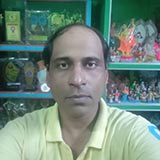Shiva’s smile in clay: A Bengal heritage fading quietly - GetBengal story
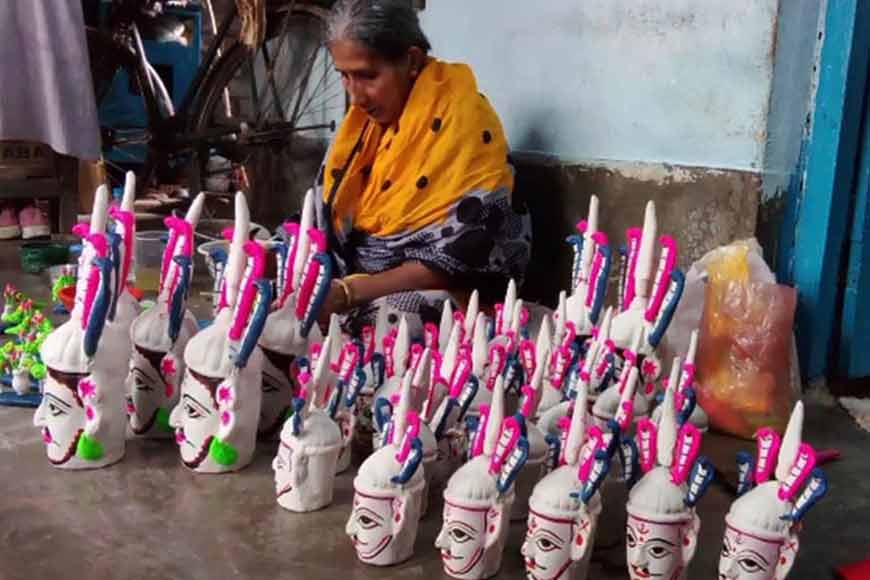
These days, many people are trying to return to their cultural roots. But in the race to keep up with modern times, many Bengalis have slowly drifted away from their own traditions. In today’s world of artificial intelligence and digital life, interest in cultural heritage is fading. As a result, the once-bustling activity around making masks of Lord Shiva for the Har-Parvati wedding in Nabadwip is now on the verge of disappearing.
From the 7th to the 9th day of the bright fortnight in the month of Chaitra, the springtime Durga Puja, worship of Singhabahini Dashabhuja Basanti, is celebrated. After the Dashami Puja, a unique tradition in Nabadwip is the symbolic wedding of Shiva. Earlier, temples like Buroshib, Jognath, and Balknath used to host grand celebrations for Shiva's wedding. But in today’s mobile-driven world, it's rare to see children collecting funds, making clay images, or organizing Har-Parvati’s wedding with the same enthusiasm.
Once, this wedding used to inspire the massive production of Shiva masks in the artisan hubs of Nabadwip. These clay masks were not just items of worship, they were expressions of the potters' artistic spirit. Today, only a handful of artisans continue this beautiful tradition. Interestingly, the Shiva seen in these masks is quite different from the usual image we know. Instead of matted hair, the mask has a golden crown, and Shiva’s face glows like that of a newlywed groom.
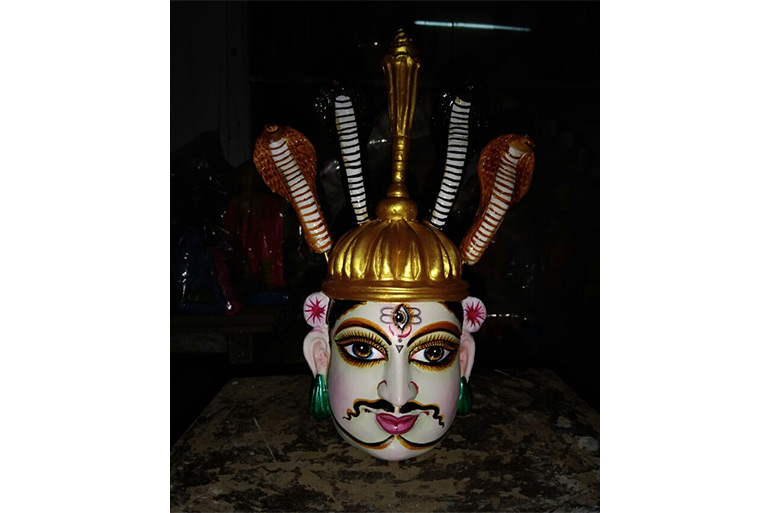
The few artists who still make these masks each have their own unique style. Through their hands, the legacy of Nabadwip’s mask-making tradition still survives—quietly, but beautifully.
There is no smile on the face. The eyes reflect wisdom. A calm, deep seriousness rests on the lean face. On the head is a golden crown with a pointed top, shaped like a spearhead. Four snakes are coiled within the crown. Hair emerging from the back of the crown gently falls over the forehead. A round red mark sits between the eyebrows. There’s a light beard along the jawline and a thin moustache. White dhatura flowers are tucked behind the ears.
For nearly fifty years, artist Kamala Modak has been crafting such exquisite masks of Shiva in Nabadwip. She learned the art of clay modelling from her father, Binay Kumar Modak. Alongside creating various types of moulded idols, she especially makes Shiva masks during the month of Chaitra.
According to her, the demand for Shiva masks is not what it used to be. The younger generation is not learning the craft, and as a result, she remains the last bearer of this tradition in her family. Kamala creates both large and small masks of Shiva. The smaller ones carry expressions similar to traditional pattachitra paintings. In Shiva’s elongated eyes, there’s a subtle, dreamy intensity—almost like a trance.
Sandhya Pal, a veteran artisan from Nabadwip’s Kapali Para, has been making Shiva masks for nearly forty years. Her late husband, artist Ajit Pal, was also a renowned Shiva mask-maker. She recalls a time when around a hundred masks would be made during the month of Chaitra. Today, that number has dropped drastically to just five to eight, and even those don’t always sell.
Sandhya Pal’s Shiva masks reflect the charm of pattachitra art. A soft, gentle smile plays on Shiva’s face, carrying both grace and wisdom. In her version, clay dhatura flowers are tucked behind Shiva’s ears. She also crafts clay Parvati idols using molds. Her Parvati is depicted with unbound flowing hair, a golden crown signifying divinity, and golden paint detailing the ornaments around her neck. She wears a sari, and a shy, tender smile lights up her face. The entire figure is mold-made, yet full of character.
In another corner of Nabadwip, Gopal Dutta of Buro Shibtala still keeps the tradition alive. His Shiva masks feature crowns carved with kalka (paisley) motifs. The eyes are vibrant and full of life. Just beneath the third eye is a red semicircle, and the centre of the forehead bears a round red mark crossed by a fine red line. According to him, the demand for Shiva masks has fallen because the younger generation’s idea of entertainment has changed.
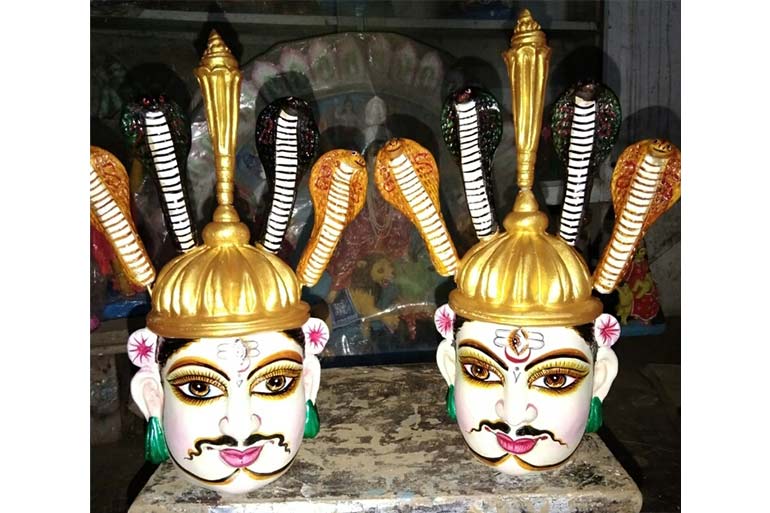
Yet, through the hands of these artisans, a vanishing heritage still breathes—delicate, detailed, and deeply rooted in Bengal’s folk culture.
The famous Shiva masks made by the late artist Narayan Chandra Pal of Gobindabati, Nabadwip, were once known across Bengal. Today, his wife, Minati Pal, continues his artistic legacy.
Her Shiva masks have large, round eyes. The crown is topped with a pointed design that looks like a trident. A red line runs between the crown and the forehead. The face of the mask reflects the charm of folk art.
Another senior artist from the same area, Gopal Pal, also makes Shiva masks in a similar style. However, his masks are slightly broader below the neck and carry a softer, sweeter expression on the face.
Gauranga Pal, an artist from Dandapanitala in Nabadwip, is known for the vibrant energy in his Shiva masks. The dhaturo flower tucked behind the ear and the akanda fruit hanging from the earlobe are both carefully crafted from clay.
According to the artist, there was a time in Nabadwip when almost every clay artist used to make Shiva masks. During Shiva's wedding celebrations, local boys and girls would also build miniature chaturdola and bashor ghar (wedding stages).
Back then, Gauranga Pal himself used to create nearly 100 masks every season. Today, that number has dropped to just three.
A calm expression rests on the large, majestic eyes. Tucked into the ear is a big clay dhaturo flower—its pollen carefully detailed and clearly visible. Atop the golden crown, which rises in a single peak, are four raised cobra hoods, ready to strike.
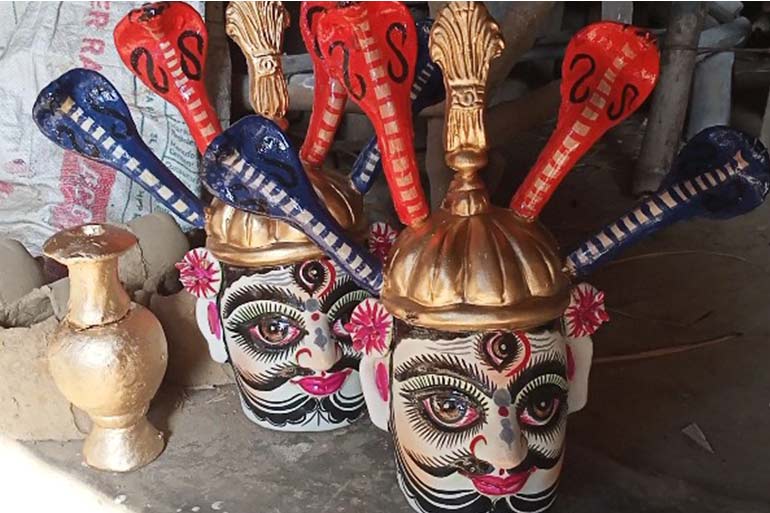
This is how Debu Pal of Nimtala, Nabadwip, continues the age-old family tradition of crafting Shiva masks. He learned the art from his father, Krishnachandra Pal, and has been making these masks for nearly 60 years.
Debu Pal says that their mask designs are inspired by the face of the local deity, Jagrat Shaiv Tirtha Yogonath. Ten years ago, the demand was high—he used to make around 100 masks every season. But this year, he has made only three.
The masks are made using sticky clay (entel mati), shaped entirely in moulds. The snakes are made separately with dedicated moulds and then carefully attached to the main structure. After unmoulding, a stick is inserted through the crown of the mask, and it is left to dry in the sun. Once the clay tightens slightly, the snakes are joined to the crown.
A small ash-red mark is drawn on Shiva’s forehead, with a light ash-coloured kolka on the tip of the nose. The mask is completely hollow from the inside—there is no solid clay base underneath.
Debu Pal still paints the masks following his family's traditional techniques, though nowadays he uses commercially available colors. Sadly, the younger generation in his family is not interested in learning this craft.
It is worth noting that various regions across India celebrate the wedding of Shiva and Parvati in their own unique ways. In recent times, Gangaour Puja—a tradition brought in by people from Rajasthan—has been gaining popularity in Kolkata and its surrounding areas. This too is a celebration of Shiva and Parvati’s marriage. Interestingly, the idols for Gangaour are now crafted by artisans from Kumartuli in Kolkata.
However, in sharp contrast, Bengal’s own age-old tradition of making Shiva masks is sadly fading away. The once-vibrant folk art that carried deep cultural and religious significance is now steadily heading toward extinction.






